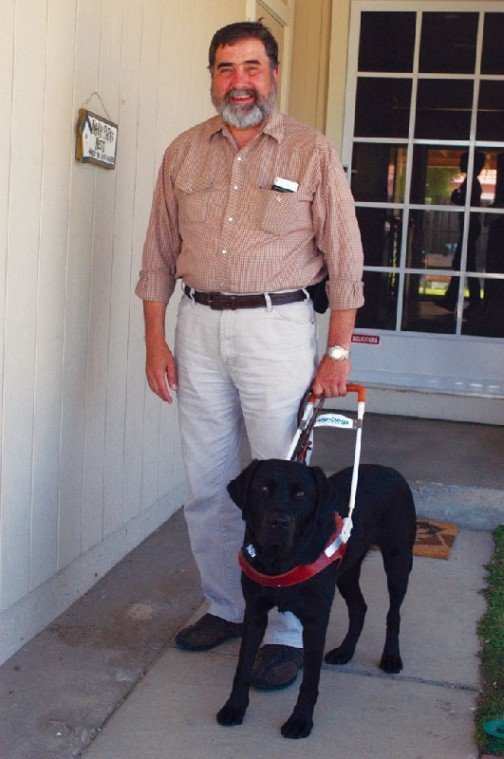Sometimes you meet some soul along life’s path who inspires the
rest of us schleps and keeps us believing that relationships are
really all we have.
Sometimes you meet some soul along life’s path who inspires the rest of us schleps and keeps us believing that relationships are really all we have.
Ernie Molina and Sancho have that special relationship born out of hard work and constant companionship. Both Ernie and Sancho are new graduates of the Guide Dogs for the Blind program located in San Rafael. The program is rigorous, lasting 28 days, six days a week, from 6:30am to 9pm. Ernie describes the experience as a “bootcamp for the blind.”
I met Ernie and Sancho at a car wash this week and was amazed at how kind they were to each other. They were accompanied by Ernie’s grandchildren and his wife, Joanne. My temptation was to cuddle up to the black Labrador but I remembered friends involved with 4-H in high school training guide dog puppies and warning us not to approach a working dog.
Ernie Molina has had dogs most of his life. Most of his life he had his sight. It wasn’t until around 1992 Ernie lost most of his ability to see distinct figures and colors, which caused him to stop driving to his job at the post office. Between 1993 and 1997, Molina was postmaster of the Cupertino Post Office. Molina had inherited a medical condition known as retinitis pigmentosa (RP) along with one of his brothers. Among his five other siblings, Ernie and his brother are the only ones to suffer from RP.
When work tasks became too difficult, Molina began working with computers and teaching himself to use accessible programs for the blind. Mastering a screenreader program known as Jaws, soon the postal department computer technicians were coming to him to learn the operations. Using Jaws, Molina was able to analyze data and send out reports for the postal service until his retirement in 2005. Using 18 months of accumulated sick time, Molina’s actual retirement date was Feb. 2, 2007.
With an active mind and a willingness to carry on, Molina has used the sick time to learn Braille (he’s up to the letter “t”), continues to learn more accessible programs, has taken cane training and applied to the Guide Dogs for the Blind Program. That’s when Sancho entered his life.
Sancho is one of the dogs who passed the requirements for the challenging work of a guide dog. Not all dogs make the cut, but as Joanne Ritter of Guide Dogs for the Blind explained, “A guide dog has to be calm, intelligent, focused, not overly curious, not too sniffy and not high energy.” The “too sniffy” dogs have been redirected to alternative careers such as bomb sniffing or search-and-rescue work where their talents are utilized. The high-energy dogs have found alternative careers in police work.
Watching Sancho at the car wash and again in the Molina home, the dog’s calm demeanor is apparent. Ernie admitted they joked about the laid back nature of Sancho during the training, but Ernie knows how to give the cue to get Sancho playing. “Let’s go Sancho, Let’s go,” Ernie sings as his workmate jumps up on his lap and play boxes. As soon as Ernie stops singing and says, “OK Sancho, all done,” the dog is again at his side and calmly waits.
Both Ernie and Sancho are working on getting their groove together.
“Our biggest challenge since graduating has been learning the streets of Morgan Hill. I tried walking downtown today,” Ernie said. “Sancho was trained to sit at a curb to wait to cross the street but the new brick sidewalks downtown have no curb and just blend into the crosswalk. With my grandchildren helping me we were happy that Sancho still stopped and sat where a curb would normally be.”
Sancho was matched to Ernie at the Guide Dogs for the Blind after the trainers observed his gate.
“When they had me walk with a test dog I couldn’t believe how winded I became. That’s the best part of having a guide dog, you move so much quicker. With my cane the landscape is awkward, but with Sancho he watches for the obstacles,” Ernie said.
While out in the community, Ernie has a polite but firm answer when people ask to pet Sancho, “Please, no, he’s working.” In fact, whenever a working dog has his harness on, the appropriate etiquette is to allow them to continue working uninterrupted. A complete etiquette guide is available on the Guide Dogs for the Blind Web site. The Web site can be accessed at www.guidedogs.com.
Another South County graduate of the Guide Dog program was Ernie’s classmate, Mary Howlett and her yellow Labrador, Teri. Ernie said having a local there was “like having a friend. Mary also goes to the Santa Clara Valley Blind Center. We had a lot of the same experiences.”
Now that Ernie and Sancho are partners, Ernie plans to travel more on public transportation freeing his wife of sight guiding work. Ernie’s dream retirement job would be to teach sight impaired people about computers and tutor them in the use of accessible programs for the blind. Instead of using the high-priced systems marketed to sight impaired computer customers, Ernie has put together a budget system.
As his wife of 39 years, Joanne observes, “He finally got what he wanted.” Looking at Sancho she adds, “He’s going to be a happy camper.”
Ciao for now.












